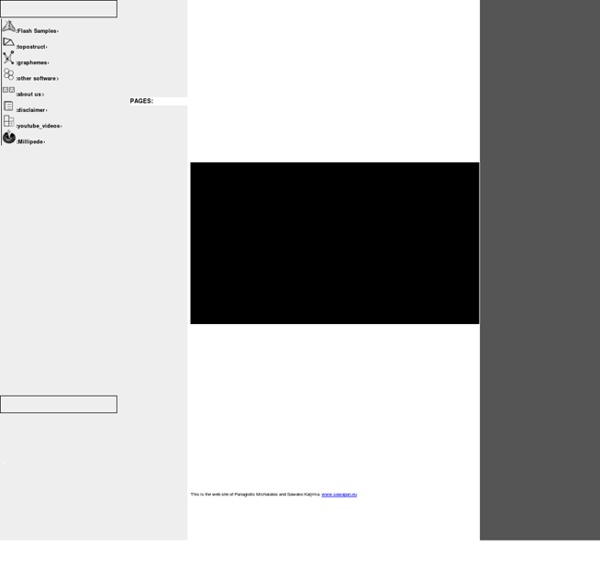



karamba 3d RABBIT 0.2 preview : 2d/3d LSystems + Turtle Interpretation Loaded: 0% Progress: 0% music: “The Slackers” Exploring LSystems in 3D MORPHOCODE is working on the new release of RABBIT - our plug-in for Rhino & Grasshopper. With RABBIT 0.2 by MORPHOCODE you would be able to create different types of LSystems: (deterministic, stochastic, context-free, parametric) and visualize them as geometry structures. Few images produced with RABBIT 0.2: What is an LSystem? In Brief: LSystem is a parallel string rewriting system. seed: Arules: A = ABB = BA The LSystem starts with the seed ‘A’ and iteratively rewrites that string using the production rules. n is the derivation length = the number of iterations n=0: An=1: ABn=2: ABBAn=3: ABBABAABn=4: ABBABAABBAABABBA… All these words form the language of the LSystem. Since their original formulation, L-systems have been adapted to modelling a wide range of phenomena including: herbaceous plantsneural networksthe procedural design of citiesgenerative artgenerative music In Brief: Feel free to comment here !
Kiwi!3D | Food4Rhino Kiwi!3D enables the integration of Isogeometric Analysis (IGA). The special characteristic of IGA lies in the usage of Non-Uniform Rational B-Splines (NURBS) as basis functions for the Finite Elements. Hence it allows to run simulations directly on NURBS without the need of meshing. Kiwi!3D includes a isogeometric Shell, Membrane, Beam and Cable element. For more information, also on the Theory of IGA and also Online Tutorials, see our website: kiwi3d.com Please Note: Because the current state of the plugIn is on going work in progress, we distribute the versions with a expiry date. Have fun! DOWNLOAD: www.kiwi3d.com/download Generative Product Design – The learning resource of design computation for product design and digital fabrication Voronoi/Delaunay Applet Mouse: Click the mouse in the drawing region to add new sites to the Voronoi Diagram or Delaunay Triangulation. Voronoi Diagram and Delaunay Triangulation radio buttons: These toggle between the Voronoi Diagram and the Delaunay Triangulation. Your current set of sites remains the same for both diagrams. Clear button: Press this to begin a new diagram with no sites. More Colorful checkbox: When it's checked each Voronoi region and each Delaunay triangle has a randomly chosen color. [If the applet used to work for you and has now quit working, you may want to try one of the older versions of the applet: Java 1.1 version; Java 5 version] What is it? The Voronoi Diagram has the property that for each site (clicked with the mouse) every point in the region around that site is closer to that site than to any of the other sites. The Delaunay Triangulation is the geometric dual of the Voronoi Diagram. Additional Information The actual data structure here is a Delaunay Triangulation.
CecilieBrandt/K2Engineering LMNts | Grasshopper+Three.JS+D3.JS As a follow-up to our previous post on two-dimensional browser interaction, we looked into Three.JS and added the library to our D3 workflow. This allows us to toggle between D3 diagrams and a 3D Model, and the user can download either an SVG file or an OBJ file from the interface. We’ve provided a series of demos and videos in this post to show the revised interface. This is an exoskeleton example, and by clicking on the cube in the top right corner, the scene switches to three-dimensional mode and you can navigate in space. The ThreeJS library is insanely impressive. Now, we mentioned some reservations about 3D browser rendering in our previous post. Unfortunately this tool isn’t ready for release to the public.
Abstract Page In this paper we introduce a biologically plausible methodology capable to automatically generate Artificial Neural Networks (ANNs) with optimum number of neurons and adequate connection topology. In order to do this, three biological metaphors were used: Genetic Algorithms (GA), Lindenmayer Systems (L-Systems) and ANNs. The methodology tries to mimic the natural process of nervous system growing and evolution, using L-Systems as a recipe for development of the neurons and its connections and the GA to evolve and optimize the nervous system architecture suited for an specific task. The technique was tested on three well known simple problems, where recurrent networks topologies must be evolved.
PolyFrame | Food4Rhino PolyFrame is a geometry-based, structural form finding plugin for Rhinoceros3d based on the principle of the equilibrium of polyhedral frames known as 3D graphic statics. In graphic statics, there are two diagrams: the form diagram that represents the geometry of the structure, and the force diagram that describes the equilibrium and the magnitude of the internal and external forces in the form. These 2D diagrams are topologically dual and geometrically dependent. PolyFrame is a computational framework that allows the construction and manipulation of reciprocal polyhedrons for structural form finding. PolyFrame and PolyFramework are developed by the Polyhedral Structures Laboratory at PennDesign, University of Pennsylvania. Principal Investigators Dr. Software Developers Dr.